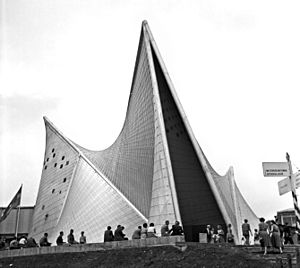Iannis Xenakis facts for kids
Iannis Xenakis (born Giannis Klearchou Xenakis) was a famous Greek-French composer, architect, and engineer. He was born in Romania on May 29, 1922, and passed away in Paris, France, on February 4, 2001.
Xenakis was a pioneer in using mathematical ideas in his music. He used concepts like set theory and game theory to create unique sounds. He also had a big impact on electronic and computer music. He often combined music with architecture, designing sounds for buildings and buildings for specific musical performances.
Some of his most important musical pieces include Metastaseis (1953–54) for orchestra. This piece gave each musician their own independent part. He also wrote percussion works like Psappha (1975) and Pléïades (1979). Xenakis created electronic music using his special UPIC system. He also put on huge multimedia shows called polytopes, which combined all his talents.
His book, Formalized Music: Thought and Mathematics in Composition, is considered one of his most important writings about music theory. As an architect, Xenakis is known for his work with Le Corbusier. They worked together on the priory of Sainte Marie de La Tourette. Xenakis also designed the Philips Pavilion for Expo 58 by himself.
Contents
The Life of Iannis Xenakis
Early Years and Challenges
Iannis Xenakis was born in Brăila, Romania, into a large Greek community. His father, Klearchos Xenakis, was a successful businessman. His mother, Fotini Pavlou, was a pianist who encouraged his interest in music. She gave him a flute and the family often went to music festivals.
Sadly, his mother passed away when he was only five years old. This was a very difficult time for young Iannis. He was then taught by governesses before being sent to a boarding school in Greece in 1932. At school, he sang in the choir and learned about music notation. He discovered the music of famous composers like Ludwig van Beethoven and Johannes Brahms. He also loved Greek traditional music.
In 1938, Xenakis moved to Athens to study architecture and engineering at the National Technical University. He also took music lessons. His studies were interrupted in 1940 when the Greco-Italian War began. Greece was later occupied by German forces.
Xenakis joined the National Liberation Front to resist the occupation. He took part in protests and later in armed resistance. After the Axis forces left, Greece entered a civil war. In December 1944, Xenakis was involved in street fighting. He was seriously injured by shrapnel from a tank blast. This injury caused him to lose sight in his left eye and left him with facial scars.
Despite these challenges, he graduated in 1947 with a degree in civil engineering. Because of his involvement in the resistance, he faced danger from the new government. He fled Greece with a fake passport and arrived in Paris on November 11, 1947. He was sentenced to death in Greece while he was away, but this was later changed to a prison sentence. The sentence was finally lifted in 1974, and he was able to return to Greece.
Architecture and New Music
Even though he was an illegal immigrant in Paris, Xenakis found work at the architectural studio of Le Corbusier. He started as an assistant but quickly took on more important projects. He worked on buildings in Nantes, France, and Chandigarh, India. He also helped design the Sainte-Marie de La Tourette priory. Xenakis designed the famous Philips Pavilion for Expo 58 on his own, based on a simple sketch by Le Corbusier. His experience in architecture greatly influenced his music. For example, his early piece Metastaseis was directly inspired by architectural ideas. Around this time, he started using "Iannis" as his professional name.
While working as an architect, Xenakis also studied music. He worked very hard, often late into the night. He sought guidance from several music teachers. Many of them did not understand his unique musical ideas. He eventually studied with Olivier Messiaen, a famous composer, from 1951 to 1953. Messiaen's classes helped Xenakis learn about different music styles and rhythms.
After studying with Messiaen, Xenakis began to develop his own style. His piece Anastenaria (1953–54) was based on an ancient Greek ritual. The third part of this work, Metastaseis, is considered his first major piece. He was briefly associated with a group of composers called the Darmstadt School, but he later disagreed with their focus on strict musical rules.
In 1953, Xenakis married Françoise Gargouïl, a journalist. Their daughter, Mâkhi, was born in 1956 and later became an artist. In 1954, Xenakis joined the Groupe de Recherches de Musique Concrète. This group studied and created electronic music. He also met conductor Hermann Scherchen, who was impressed by his music and supported his work.
By the late 1950s, Xenakis started to gain recognition for his music. He received his first composition award in 1957. In 1958, he created an electronic music piece called Concret PH for the Philips Pavilion. By 1960, he was well-known enough to receive a commission from UNESCO for a film soundtrack.
Later Life and Legacy
After leaving Le Corbusier's studio in 1959, Xenakis focused on composing and teaching. He quickly became known as one of Europe's most important composers. In 1965, he became a French citizen. He was especially known for his research in computer-assisted music. In 1966, he founded a research center called EMAMu (later CEMAMu) for this purpose. He also taught at Indiana University and the Sorbonne.
Xenakis often gave lectures and taught composition around the world. His music was performed at many festivals. Some of his notable students became famous composers themselves. In 1983, he became a member of the Académie Française, a prestigious French institution.
He also wrote many articles and essays about music. His book, Formalized Music, which explained how he used mathematics in his compositions, became very famous.
Xenakis was an atheist, meaning he did not believe in a god. He believed that death was the final event in human life. He once wrote that music could be a "mystical (but atheistic) asceticism," meaning it could be a deeply spiritual experience without being religious.
Xenakis completed his last musical piece, O-mega, in 1997. His health declined over the years, and he could no longer work. In 1999, he received the Polar Music Prize. This award recognized his powerful and passionate works that made him one of the most important composers of his time.
After a long illness, Iannis Xenakis passed away in his Paris home on February 4, 2001, at the age of 78. He was cremated, and his ashes were given to his family. His wife, Françoise, passed away in 2018, and his daughter, Mâkhi, continues his artistic legacy.
Xenakis's Unique Musical Works
Xenakis was famous for using math, statistics, and physics in his music. For example, he used ideas from the study of gases in his piece Pithoprakta. He used the way points are spread out on a flat surface in Diamorphoses. He also used game theory in pieces like Duel and Stratégie. He even used Brownian motion, which describes the random movement of particles, in his work N'Shima.
Even though electronic music was a small part of his work, it was very important for music in the late 20th century. Some of his key electronic pieces include Concret PH (1958), Bohor (1962), and La légende d'Eer (1977).
By 1979, Xenakis created a computer system called UPIC. This system could turn drawings into music! Since he was also an architect, some of his drawings looked like organic shapes or building structures. UPIC could read the curves and lines in these drawings and turn them into sounds in real time. This meant a drawing could become a musical composition. Mycenae-Alpha was one of the first pieces he made using UPIC.
Xenakis also developed a special computer algorithm called dynamic stochastic synthesis. This allowed him to create new sounds and musical forms by using random movements, similar to a random walk. He used this in his piece GENDY. He could control these random movements to keep the sounds within certain limits, creating a balance between order and chaos.
Even though Xenakis used a lot of math, his music is known for being very powerful and physical. Music critics have described his works as "rawest, wildest music in history" and "sounds that explode around the ears." They say his music has a "terrifying emotional impact" and a "truly majestic otherness."
One critic, Tom Service, praised Xenakis's music for its "shattering visceral power" and "sheer, scintillating physicality." He noted that Xenakis's music connects deeply to the natural world, like the physics of stars and gas molecules. Service said that Xenakis's music allows listeners to experience "seismic events close at hand" and be "at the middle of a musical happening of cosmic intensity." He even compared listening to Xenakis's music to being "in the eye of a musical storm that will invigorate, inspire, and awe."
Writings
- Xenakis, Iannis. 2001. Formalized Music: Thought and Mathematics in Composition (Harmonologia Series No. 6). Hillsdale, New York: Pendragon Press. ISBN: 1-57647-079-2
See also
 In Spanish: Iannis Xenakis para niños
In Spanish: Iannis Xenakis para niños




